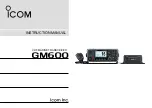
NAVIOR-24S
™
Appendix D
NMEA 0183 Communication Interface
170
NAVIOR-24S ™
Revision
V1.00 20.05.2008
NMEA 0183 Message Format
The NMEA 0183 protocol covers a broad array of navigation data.
This broad array of information is separated into discrete messages which convey a specific set of
information. The entire protocol encompasses over 50 messages, but only a sub-set of these
messages apply to a GPS receiver like the NAVIOR-24S GPS/GLONASS receiver. The NMEA
message structure is described below.
$IDMSG,D1,D2,D3,D4,.......,Dn*CS[CR][LF]
“$”
The “$” signifies the start of a message.
ID
The talker identification is a two letter mnemonic which describes the
source of the navigation information. The GP identification signifies
a GPS source.
MSG
The message identification is a three letter mnemonic which
describes the message content and the number and order of the data
fields.
“,”
Commas serve as delimiters for the data fields.
Dn
Each message contains multiple data fields (Dn) which are delimited
by commas.
“*”
The asterisk serves as a checksum delimiter.
CS
The checksum field contains two ASCII characters which indicate the
hexadecimal value of the checksum.
[CR][LF]
The carriage return [CR] and line feed [LF] combination terminate
the message.
NMEA 0183 messages vary in length, but each message is limited to 79 characters or less. This
length limitation excludes the “$” and the [CR][LF]. The data field block, including delimiters, is
limited to 74 characters or less.
In the accepted sentences the address of the sentences consists of the two-character code of the
transmitter and three-character shaper indicating a format and a data type. For space navigation
systems instrumentation the code of the transmitter GP is used.
In the correct sentences the address consists of character P, mnemonics of the manufacturer of
instrumentation and data type.
The data are transmitted by fields. The field is a set of alphanumeric characters of a variable length
limited to a separator. A separator of fields is character of a comma.
Byte of the check total is transmitted as two hexadecimal signs. The check total settles up as
operation «eliminating or» for all characters of the sentences from the sign $ up to * (characters $
and * are not taken into account).
















































